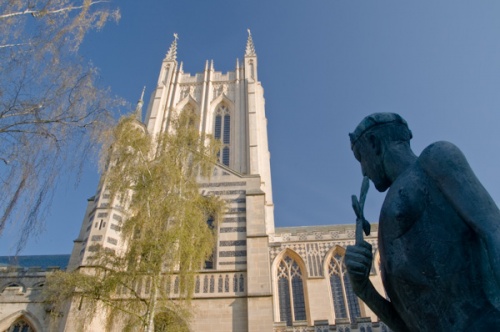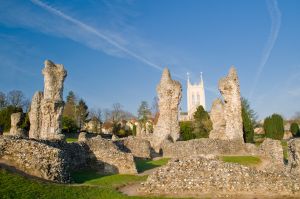
History of Bury St Edmunds
One of the most common of these says that Edmund was a native of Nuremberg, who came to Suffolk in 841 to take up the throne. A devout Christian, Edmund was captured by the invading Danes in 870. He refused to abjure his faith, and was beheaded at Hoxne.
According to the story, Edmund's body was recovered by his followers, but his head was missing. His men searched high and low for 40 days, and just when they despaired, they heard a voice calling to them from a thicket.
They traced the voice to the centre of the wood and found a wolf, the head cradled protectively between its paws. They reunited the head with Edmund's body, and they knit together. In memory of the story, the town crest of Bury shows a wolf with a human head.
Edmund was first buried at Hoxne, then his remains were moved to the abbey of Beodricsworth when he was canonised in AD 910. In honour of the new saint, the monastery was renamed St Edmundsbury. A shrine to Edmund was erected, and soon became a popular destination for pilgrims. In 1032 Canute granted the monastery abbey status, and the shrine was incorporated into the church.

The cult of St Edmund was so popular that he was for centuries the patron saint of England until that role was taken over by St George. The abbey was one of the richest and most influential in the country, in part due to the wealth of East Anglia from the flourishing wool trade in the medieval period.
In 1203 King John visited St Edmund's Abbey and fueled a scandal by reclaiming jewels his mother had earlier presented to the church.
According to traditional histories of Bury St Edmunds, a gathering of the most powerful barons of England met here under the leadership of the Archbishop of Canterbury, Stephen Langton, on St Edmund's feast day, 1214.
The barons declared their intention to make King John abide by terms of a charter of Henry I, the terms of which became the basis of the Magna Carta the following year. Unfortunately, there seems little historical basis to the gathering, but apocryphal stories about it gave the town its motto, 'Shrine of a king, cradle of the law'.
The abbey was substantially rebuilt in the 15th century but fell victim to Henry VIII's Dissolution of the Monasteries. The remains of the monastic buildings lie scattered in a pleasant garden area behind St Edmundsbury Cathedral. The cathedral started life as St James church in the 15th century. In 1914 the church was raised to cathedral status.

The interior features a wonderful hammerbeam roof, decorated with 38 carved angels. But some would argue that the cathedral is not the finest historic church in Bury St Edmunds, for just a short walk along Angel Hill is the 12th-century parish church of St Mary's, one of the finest buildings in East Anglia.
St Mary's also has a superb hammerbeam roof (photo), and houses the tomb of Mary Tudor (photo), sister of Henry VIII, who was also Queen of France and Duchess of Suffolk. Mary's tomb was moved to St Mary's from the abbey church when the Abbey was suppressed by her brother.
In the Great Churchyard beside the cathedral is Samson's Tower (photo), which once comprised the east end of the abbey buildings. Fronting Angel Hill is Norman Tower (photo), built in 1120, which now acts as the bell tower for the cathedral. On the far side of the cathedral, giving access to the Abbey Gardens is Abbeygate (photo), a beautiful early medieval tower which dates from the 12th century.
Across Angel Hill from the cathedral is the imposing Angel Hotel (photo), immortalised by Charles Dickens in his Pickwick Papers. Dickens himself stayed at the Angel, and gave public readings at the nearby Athenaeum (photo).
A short stroll away, at one end of the Buttermarket, is the Theatre Royal, built by the same architect who designed the National Gallery. The Theatre is the only original Regency theatre in England still standing. Near the Theatre is Greene King brewery (photo), founded in 1799.
Visitors can tour the brewery and taste the results! Away from the centre of town is the Suffolk Regimental Museum, tracing the heritage of the regiment back to 1685. Another historic building is The Guildhall, the oldest complete civic building in Britain, dating to the late 12th century, and now open for arranged tours.

Up hill from the cathedral stands the Victorian Corn Exchange (photo), an elegant building standing across from the Nutshell, the smallest pub in England. At the far end of Buttermarket is Moyses Hall, a marvellous medieval survivor. The Hall dates to 1180 and is one of the oldest domestic buildings in the country.
Over its long life, the Hall has served as a residence, a prison, a workhouse, a police station, and railway offices. Moyses Hall is now a museum housing objects spanning the history of the Bury area.
The old historic core of Bury, especially around Buttermarket, is an absolute delight to ramble around, with numerous timber-framed buildings and many examples of decorative pargetting that is such a characteristic of Suffolk architecture.
Bury as a whole offers so much of historic interest to visitors. The official Bury tourism website has a very handy town map which you can print off before visiting.












 We've 'tagged' this attraction information to help you find related historic attractions and learn more about major time periods mentioned.
We've 'tagged' this attraction information to help you find related historic attractions and learn more about major time periods mentioned.


